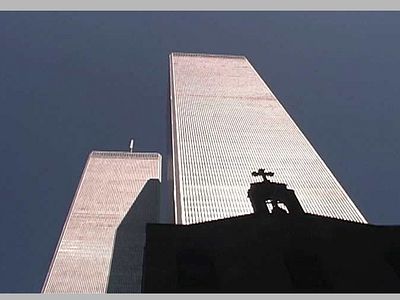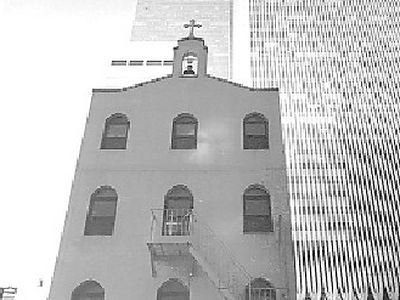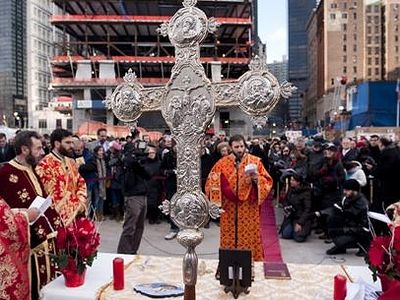 The Church of St. Nicholas the Wonderworker before the terrorist attacks
The Church of St. Nicholas the Wonderworker before the terrorist attacks
But Orthodox Christian people, both New Yorkers and tourists, do not so much crane their necks counting the stories of the newly-built WTC skyscraper as try to make out—amid the masses of cranes and the buildings striving to outdo each other in how fast they can be built—the place marked by the beginning of the reconstruction of one Christian victim of the September 11 terrorist attack: the tiny St. Nicholas Greek Orthodox Church, buried under the burning towers that collapsed onto it.
Fr. Panteleimon Papadopoulos, archdeacon of the head of the Greek Orthodox Church in America Archbishop Demetrios (Patriarchate of Constantinople), found out about what happened, together with His Eminence, while they were outside of New York.
“On September 10, 2001, Archbishop Demetrios was present at an official event at Tufts University, Medford, Massachusetts,” recalls Archdeacon Panteleimon. “The next day around 9 o’clock in the morning, when we were getting ready to go to Logan Airport and return home, I turned on the television. It showed a New York building on fire, but I did not immediately grasp what had occurred. I went to the Archbishop in the hotel room and we turned on the television and saw the burning towers of the World Trade Center. In the short time that it took me to get to Despota (endearing Greek term for “bishop”), one more plane had crashed into the skyscraper.
“We also found out from the news that earlier, two passenger planes had taken off from the very airport that we had to fly out of and had been hijacked by terrorists and had crashed into the World Trade Center towers. Can you imagine what my wife in New York was going through? Nobody knew what
flight we were supposed to return on! We couldn’t even call home, because the connection with New York had been cut off.”
Several months earlier that year, Panteleimon Papadopoulos had graduated from Holy Cross Greek [Orthodox] Seminary, had been ordained to the rank of deacon, and had begun to serve with Archbishop Demetrios and accompany the hierarch—who did not like big cortèges—on trips.
 Archbishop Demetrios and Archdeacon Panteleimon
Archbishop Demetrios and Archdeacon Panteleimon
Now, after 12 years, Archdeacon Panteleimon—a connoisseur of Russian Church music—serves as before with His Eminence and supervises the School of Byzantine Chant that he founded in New York.
Fr. Panteleimon was born in the state of Connecticut, but years of the lives of his paternal grandparents are connected with Russia.
His grandmother, Melpomeni, an ethnic Pontus Greek, was born in Sochi. His grandfather, Stephan, was born in Argyroupol, in the Pontus region by the Black Sea, which is on the territory of what is now Turkey. At the time of the Turkish genocide in 1916, all his family, with the exception of his father, was exterminated. Fr. Panteleimon's great-grandfather, Haralampos, was a teacher. They tried to track him down, but he managed to emigrate with his 9-year-old son to the Black Sea coast of Russia, and settled in Odessa.
"My great-grandfather spoke Russian, Greek, and the Pontus dialect fluently," relates Fr. Panteleimon. "In 1917 there started to be unrest in Russia, too, and the revolution broke out. Once my great-grandfather said to his friends, "Why don't you move to my country?"--meaning Pontus. Someone who was there reported to the militia that he supposedly was plotting something against the government. The Bolsheviks sent my great-grandfather first to prison, and then to prison camp.
"Thus you may say that my grandfather became an orphan for the second time. When they freed my great-grandfather, he and his son immediately moved to northern Greece, to the city of Ptolemaida. There, Grandpa Stephan, was the church warden at St. Stephan’s Church for 43 years.”
One of his relatives calculated that there were, all together, 43 priests in the Papadopoulos family. Fr. Panteleimon himself can name at least nine out of his closest family, and the surname Papadopoulos—aside from the fact that it points to descent from the Pontus region—means “priest’s son” in Greek.

“I myself saw the place of the tragedy 11 days after the terrorist attack. Archbishop Demetrios and I came in order to serve a pannikhida (service for the dead) for those who had perished and to see the progress of the excavation on the site where our church had been. The vicinity of the former World Trade Center resembled a war zone: we had to pass through several police cordons, where we were thoroughly checked….
“I remember the two huge skeletons of the WTC buildings, which were still burning. Hundreds of cameramen. I will never forget the smell: bodies were burning.… It was a horrible odor. And the
aftertaste in your mouth… Particles of burning remains were flying through the air, and whether you wanted to or not you had to inhale them. The three-story Church of St. Nicholas was crushed by the weight of the falling building and virtually disappeared under the ground, forming a crater. We served a pannikhida for the Orthodox dead. Archbishop Demetrios, first and foremost, was anxious about the fate of the relics that the last emperor of Russia, Nicholas II, gave to the church: St. Nicholas of Myra in Lycia, St. Savvas the Sanctified, and Great-Martyr Catherine.
“The man who was responsible for the excavation and investigation of the territory on the site of the church turned out to be a Greek. The archbishop asked him to do the excavation as carefully as possible, and he assured Despota that they did not let backhoes in there: they excavated and cleaned everything by hand or with the help of delicate instruments. Soldiers were also working on the site piled with rubble, and they came up to Archbishop Demetrios and asked his blessing.
“Shortly after our visit to Ground Zero, calls started coming in to the Archdiocese about objects found at the site of the church. Out from under the rubble were recovered books in Greek, one of which was a Bible with burnt pages; a small bell; candlestands… Icons had been found: of the Mother of God “Life-GivingSpring” and of St. Dionysios of Zakynthos.
 A charred Bible found on the site of the tragedy
A charred Bible found on the site of the tragedy
 Seven-branched candlestick on the site of the tragedy
Seven-branched candlestick on the site of the tragedy
 The miraculously preserved Icon of the Life-Bearing Spring
The miraculously preserved Icon of the Life-Bearing Spring
“With Archbishop Demetrios’ blessing we succeeded in capturing on film the material witness that had occurred of the parish life of the buried St. Nicholas Church – the fire, water and days of tragedy at Ground Zero. For twelve years, while complex negotiations have been going on with the New York Port Authority Transportation Department about the fate of the future church, these objects have been kept on the left side of the altar in the private chapel of Sts. Peter and Paul in the Greek Archdiocese building in New York, and will be kept there until the new church is completed. The icon of St. Dionysios is here, though, in the altar.
“All twelve years, on the anniversary of the tragedy, only a few paces from the famous 9/11 Memorial, Archbishop Demetrios has served a pannikhida here for the repose of more than 50 Orthodox Americans of Greek descent, who were among the 3,000 who died. For twelve years, on the eve of the feast of St. Nicholas, Despota has performed the services on the site of the church, just as they were served for more than 80 years, when the church nurtured a comparatively small community of Greeks – 70 families (not counting people of various nationalities – employees of the Center, New Yorkers and visitors who would come here every day to pray). On the site of the church a tent was set up, where a photographic image of the altar of St. Nicholas Church, transferred onto cloth, served as the sanctuary. Among the clergy who served with His Eminence were the rector of St. Nicholas Church, Fr. John Ramos, and Archdeacon Panteleimon.
“Once, when we were leaving Ground Zero after the service,” recalls Fr. Panteleimon, a correspondent from CNN asked Demetrios, ‘Isn’t your faith shaken in the face of all this tragedy?’ ‘Shaken?’ asked Despota in return. ‘Didn’t you see the outpouring of love surrounding us? People from all over the world are offering help in rebuilding the church. A tragedy of tragedies, but didn’t you notice this unbelievably amount of love?’
“Almost immediately after the loss of St. Nicholas Church donations and offers of help started coming in,” continues Fr. Panteleimon. ‘From the Greek government and many other foreign organizations. The American National Association of Plumbers offered to do all the pipe-laying work free of charge. Electricians, iconographers, interior designers, and other specialized workers promised their help gratis. The head of the Patriarchal parishes in the USA, Bishop Paul (Ponomarev; now Metropolitan of Ryazan and Mikhailov), donated a bell. In the city of Norwalk, Connecticut, one of the streets bears the name of St. Nicholas, and practically all of the people who live there – not only Orthodox Greeks – have sent a bundle of checks – donations towards the building of the church.
 Pannykhida on the site of the tragedy
Pannykhida on the site of the tragedy
But it is doubtful that anyone imagined that the road to getting permission to build the church would drag out for ten long years. In 2009 the New York Port Authority Transportation Department, which was actively carrying on construction at Ground Zero, and which in the beginning had promised not only the area of land under the church, but also financial help, unilaterally broke their agreements with the Greek Archdiocese about reserving a plot of land for the construction, and cast doubt on the very possibility of rebuilding St. Nicholas Church. It took long drawn out court proceedings and investigations before the Port Authority, with the help of the governor of New York, Andrew Cuomo, signed the final agreement with the Greek Archdiocese.
The new church is projected to be completely finished by 2016 – the 100th anniversary of St. Nicholas parish – and will become one of the significant parts of the new World Trade Center building complex. As before, the church will be open daily for everyone: people who work in the neighborhood, residents, and guests of New York.
Archbishop Demetrios said that, upon the completion of the construction of the World Trade Center, up to 250,000 people would pass by and drop into the church daily – 70 million a year! And the new church will be a place of prayer and comfort for all the visitors to Ground Zero, first and foremost for the families whose relatives were buried under the debris. Finally people will be able to come, put up candles, and pray for them, “for they have no other cemetery; here is the place of their repose.”
In the same way, the fragments of the relics of SS Nicholas and Savvas and of Great-Martyr Catherine that were once presented by the Greek community in Russia remain buried in the business quarter of the megalopolis. But perhaps they were put there by God’s Providence not only on the place of tragedy and sorrow, but also of faith, hope and love, sanctifying it for building of a new house of God in the center of New York.



